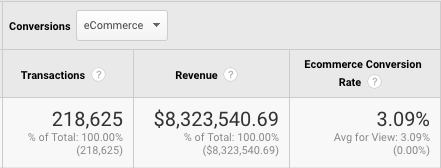One of the most common questions I hear from clients is “how can I get more search traffic to the pages that are most important for my business?” A very understandable concern. But after digging a little deeper into their business, industry, and analytics data, I sometimes find that their issue is not a lack of organic traffic. Rather, it’s an issue of conversion rate optimization (CRO).
All the traffic in the world won’t affect your bottom line if on-page obstacles are preventing visitors from completing a desired action on your website. It’s important to evaluate how users interact with your key landing pages so you can determine if they need conversion rate optimization.
Determining if a Page Needs CRO
Before making any changes to your page(s), you’ll want to make sure that the problem is, in fact, related to conversion friendliness. Examine your page’s engagement metrics in Google Analytics to determine if optimization is needed. Here are few things to look for:
Bounce Rate: Is the bounce rate for your page significantly higher or lower than the average bounce rate for your entire site? Bounce rate refers to the percentage of single-page sessions in which there was no interaction with the page. These users leave your site without taking any action.
An abnormally high bounce rate is a strong indicator that your page may not be sufficiently meeting the needs of your audience and CRO may be in order. For instance, if your domain’s average bounce rate is 43.62% and one of your key landing pages maintains a bounce rate of 88.57%, it’s time to re-evaluate how this page is addressing the consumer’s needs. Pages/Session: The optimal number of pages viewed per session will vary from website to website because every site’s conversion funnel is different. If you’re driving traffic to a service page that has a quote request form directly on it, then your high-value users are going to visit fewer pages per session than traffic landing on a URL that links to an entirely separate “request a quote” page. So, the important thing to do when examining this metric is compare the URL’s pages/session to the number of pages users would need to visit if they were to convert. For example, if your site’s conversion funnel requires at least four pages to be viewed in a session, but your landing page produces an average of 1.5 pages/session, it may be time to consider CRO.
Pages/Session: The optimal number of pages viewed per session will vary from website to website because every site’s conversion funnel is different. If you’re driving traffic to a service page that has a quote request form directly on it, then your high-value users are going to visit fewer pages per session than traffic landing on a URL that links to an entirely separate “request a quote” page. So, the important thing to do when examining this metric is compare the URL’s pages/session to the number of pages users would need to visit if they were to convert. For example, if your site’s conversion funnel requires at least four pages to be viewed in a session, but your landing page produces an average of 1.5 pages/session, it may be time to consider CRO.
Avg. Session Duration: Like the pages/session metric, there is no “perfect” session duration that applies to all sites. This number will depend on your industry, the website’s navigation structure, as well as your site’s conversion funnel. Look for abnormalities in a page’s average session duration in relation to the average for your entire domain. Extreme variances in either direction could indicate that there is an obstacle keeping users from converting. Conversion Rate: A good place to start is to identify the average conversion rate for your industry and benchmark your page’s performance against it. Are you above or below average? There is almost always room for improvement, so even if your landing page is hovering around the industry’s average conversion rate, I recommend looking for ways to improve the users’ on-page experience to encourage more goal completions.
Conversion Rate: A good place to start is to identify the average conversion rate for your industry and benchmark your page’s performance against it. Are you above or below average? There is almost always room for improvement, so even if your landing page is hovering around the industry’s average conversion rate, I recommend looking for ways to improve the users’ on-page experience to encourage more goal completions.
Remember that the conversion rate metric is highly contextual. For instance, a website selling $15 makeup brush sets will likely maintain a higher conversion rate than a site selling business consulting services. Your conversion rate also depends on how you are defining a conversion in Google Analytics. Does an “add to cart” selection register as a conversion for your site? How about an email newsletter signup or a PDF download? The bigger the commitment required for a goal completion, the lower the goal’s conversion rate will be.
Next Steps: A/B Testing
Now that you’ve identified which key landing pages could benefit from CRO updates, it’s time to address areas of opportunity within the page’s copy, layout, internal links, load speed, calls to action, and more. Once you’ve eliminated the obstacles that have been keeping users from converting on your page, test the newly updated page against the old version to see which one converts better. Test, adjust, and test again until you create a landing page that achieves your optimal conversion rate.
Do You Have a Landing Page that Could Use Some CRO?
Send us a link and we’ll check it out. Our team can help identify areas of opportunity for your page to capture more conversions from the traffic your site is already receiving.
